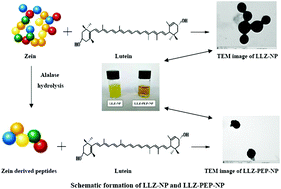当前位置:
X-MOL 学术
›
Food Funct.
›
论文详情
Our official English website, www.x-mol.net, welcomes your feedback! (Note: you will need to create a separate account there.)
Zein-derived peptides as nanocarriers to increase the water solubility and stability of lutein
Food & Function ( IF 6.1 ) Pub Date : 2018-01-16 00:00:00 , DOI: 10.1039/c7fo01652b Yan Jiao 1, 2, 3, 4, 5 , Xiqun Zheng 1, 2, 3, 4 , Ying Chang 1, 2, 3, 4 , Dajing Li 4, 5, 6, 7 , Xiaohong Sun 1, 2, 3, 4 , Xiaolan Liu 1, 2, 3, 4
Food & Function ( IF 6.1 ) Pub Date : 2018-01-16 00:00:00 , DOI: 10.1039/c7fo01652b Yan Jiao 1, 2, 3, 4, 5 , Xiqun Zheng 1, 2, 3, 4 , Ying Chang 1, 2, 3, 4 , Dajing Li 4, 5, 6, 7 , Xiaohong Sun 1, 2, 3, 4 , Xiaolan Liu 1, 2, 3, 4
Affiliation

|
Zein and its derived peptides have been used as nanocarriers for bioactive components. Lutein, as well as other xanthophylls, are characterized by blue light filtering and anti-oxidant properties. However, lutein is unstable and has low water solubility, poor absorption, and low bioavailability. In order to protect lutein from oxidative degradation, and to enhance its solubility and dispersibility, stability and bioactivity, lutein-loaded zein nanoparticles (LLZ-NP) and zein-derived peptide nanoparticles (LLZ-PEP-NP) were prepared by the solvent diffusion method. Compared to LLZ-NP, LLZ-PEP-NP possessed good physicochemical properties, including particle size, polydispersity index, zeta potential, entrapment efficiency and in vitro stability. Specifically, transmission electron microscopy (TEM) images showed that LLZ-PEP-NP had a spherical form with a nanometric size and lutein was efficiently loaded into zein-derived peptides through self-assembly. Dynamic light scattering (DLS) results demonstrated that LLZ-PEP-NP had a narrow size distribution in the range of 200–300 nm and a decreased zeta potential compared to that of LLZ-NP. The lutein entrapment efficiency (EE%) of LLZ-NP and LLZ-PEP-NP was more than 85%, while LUT-PEP-NP showed higher lutein entrapment efficiency because of the better capacity of peptides bound with lutein. Nanoencapsulation of lutein into LLZ-PEP-NP resulted in a significantly higher solubility compared to nanoencapsulation of lutein into LLZ-NP and free lutein. The stabilities of lutein in zein-derived peptide nanoparticles in simulated gastric fluid (SGF) and simulated intestinal fluid (SIF) were improved. These results suggest that zein-derived peptides have the potential to be used as nanocarriers to enhance the solubility and stability of lutein, which can further improve its bioavailability.
中文翻译:

玉米醇溶蛋白衍生的肽作为纳米载体,以增加叶黄素的水溶性和稳定性
玉米醇溶蛋白及其衍生的肽已被用作生物活性成分的纳米载体。叶黄素以及其他叶黄素的特征在于蓝光过滤和抗氧化特性。但是,叶黄素不稳定,水溶性低,吸收性差,生物利用度低。为了保护叶黄素免于氧化降解并提高其溶解度和分散性,稳定性和生物活性,通过溶剂扩散制备了载有叶黄素的玉米醇溶蛋白纳米颗粒(LLZ-NP)和玉米醇溶蛋白衍生的肽纳米颗粒(LLZ-PEP-NP)。方法。与LLZ-NP相比,LLZ-PEP-NP具有良好的理化性质,包括粒径,多分散指数,ζ电势,包封率和体外稳定。具体地,透射电子显微镜(TEM)图像显示LLZ-PEP-NP具有纳米尺寸的球形形式,并且叶黄素通过自组装有效地装载到玉米醇溶蛋白衍生的肽中。动态光散射(DLS)结果表明,与LLZ-NP相比,LLZ-PEP-NP在200-300 nm范围内具有较窄的尺寸分布,并且其Zeta电位降低。LLZ-NP和LLZ-PEP-NP的叶黄素包封率(EE%)大于85%,而LUT-PEP-NP则具有更高的叶黄素包封率,这是因为与叶黄素结合的肽具有更好的容量。与将叶黄素纳米囊化为LLZ-NP和游离叶黄素相比,将叶黄素纳米囊化为LLZ-PEP-NP产生了更高的溶解度。叶黄素在模拟胃液(SGF)和模拟肠液(SIF)中玉米醇溶蛋白衍生的肽纳米颗粒中的稳定性得到改善。这些结果表明,玉米醇溶蛋白衍生的肽具有用作纳米载体以增强叶黄素的溶解性和稳定性的潜力,这可以进一步提高其生物利用度。
更新日期:2018-01-16
中文翻译:

玉米醇溶蛋白衍生的肽作为纳米载体,以增加叶黄素的水溶性和稳定性
玉米醇溶蛋白及其衍生的肽已被用作生物活性成分的纳米载体。叶黄素以及其他叶黄素的特征在于蓝光过滤和抗氧化特性。但是,叶黄素不稳定,水溶性低,吸收性差,生物利用度低。为了保护叶黄素免于氧化降解并提高其溶解度和分散性,稳定性和生物活性,通过溶剂扩散制备了载有叶黄素的玉米醇溶蛋白纳米颗粒(LLZ-NP)和玉米醇溶蛋白衍生的肽纳米颗粒(LLZ-PEP-NP)。方法。与LLZ-NP相比,LLZ-PEP-NP具有良好的理化性质,包括粒径,多分散指数,ζ电势,包封率和体外稳定。具体地,透射电子显微镜(TEM)图像显示LLZ-PEP-NP具有纳米尺寸的球形形式,并且叶黄素通过自组装有效地装载到玉米醇溶蛋白衍生的肽中。动态光散射(DLS)结果表明,与LLZ-NP相比,LLZ-PEP-NP在200-300 nm范围内具有较窄的尺寸分布,并且其Zeta电位降低。LLZ-NP和LLZ-PEP-NP的叶黄素包封率(EE%)大于85%,而LUT-PEP-NP则具有更高的叶黄素包封率,这是因为与叶黄素结合的肽具有更好的容量。与将叶黄素纳米囊化为LLZ-NP和游离叶黄素相比,将叶黄素纳米囊化为LLZ-PEP-NP产生了更高的溶解度。叶黄素在模拟胃液(SGF)和模拟肠液(SIF)中玉米醇溶蛋白衍生的肽纳米颗粒中的稳定性得到改善。这些结果表明,玉米醇溶蛋白衍生的肽具有用作纳米载体以增强叶黄素的溶解性和稳定性的潜力,这可以进一步提高其生物利用度。


























 京公网安备 11010802027423号
京公网安备 11010802027423号